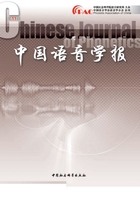
德宏傣语长短元音声学及感知研究
王璐 孔江平
摘要 傣语系属汉藏语系壮侗语族(侗台语族)壮傣语支(台语支),德宏傣语是傣语主要方言之一,其“元音a+韵尾”的组合存在长短元音a的对立,韵尾可分为(1)元音韵尾、(2)鼻韵尾、(3)塞音韵尾三类。本文对三类组合进行声学分析发现时长上,(1)、(2)组长短元音a在音节中占比不同,组内总音节时长相同,(3)组中长元音音节时长长于短元音;共振峰方面,(1)组长短元音a共振峰值F1、F2有显著差异,(2)、(3)组长短元音a共振峰值F1有显著差异;音高各组组内均无显著差异。基于声学分析结果设计的感知实验研究结果显示,(1)组范畴化程度最高、(2)组次之、(3)组最低。
关键词 德宏傣语;长短元音;声学分析;范畴感知
Acoustic Analysis and Perception of Long vs.Short Vowel of Dai Language
WANG Lu KONG Jiangping
Abstract The Dai language family belongs to the Sino-tibetan Zhuang-dong (Dong-tai) Zhuang-dai (Tai) branch,and Dehong Dai language is one of the main Dai dialects.The vowel a in “a+final”could be long or short one,and the finals can be divided into (1) vowel finals,(2) nasal finals,(3) stop finals.In this paper,the acoustic analysis shows that long vs.short vowels in (1),(2) have different proportions in syllables,and the total syllable duration in the group is the same,while the total syllable duration of long vowels in (3) is longer than that of short vowels.As for the formant,F1 and F2 of long and short vowel a in (1) are significantly different and F1 long and short vowel a in (2),(3) are significantly different.And the results of perception experiment show that (1) has the highest degree of categorization,followed by (2) and (3).
Key words Dehong Dai language;Long vs.short vowel;Acoustic analysis;Categorical perceprion